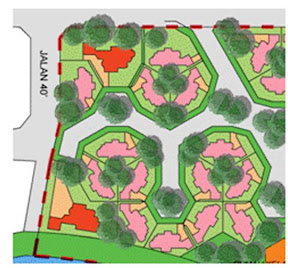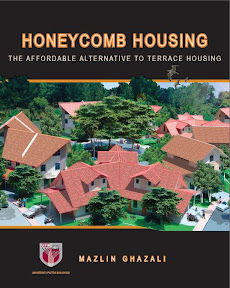Does the Honeycomb layout take into account the sun's path?
Malaysia is an equatorial rainforest, hot and humid all year round. Ideally, windows would face N-S, avoiding the morning sun in the East, and certainly the afternoon sun in the West. Yet, if the windows are shaded, heat gain can be minimized. A comparison of two quadruplex houses, one in the N-S orientation, the other in E-W orientation shows only a small difference in temperature the hottest period of the year (details later).
Even so, this simulation does not take into account the potential shade that can be gained from planting fast-growing trees that we have - that can grow 40’ high and almost the same across within 5 years. In fact, one of the main reason for the Honeycomb concept is to have parks, small, yet large enough to grow such trees. There just isn’t enough space on the standard 40’ right of way in our housing estates.
Outside of the tropics, where we want mainly south-facing windows, the Honeycomb layout with linked houses may not be suitable, because some houses will have to face elsewhere. But for detached single family homes in a Honeycomb layout, we can design the house to have windows facing where we want them.
Posted by
Mazlin Ghazali
at
Thursday, April 26, 2007
0
comments
![]()
Can Fire Trucks access a Honeycomb Cul-de-sac?
The drawing below shows how a fire engine can easily turn round a honeycomb cul-de-sac. There is plenty of space!
Posted by
Mazlin Ghazali
at
Monday, April 23, 2007
0
comments
![]()
Will consumers accept honeycomb houses?
We had done about 10 opportunity surveys prior to 2006 at exhibition events and lectures to gauge the response of consumers to Honeycomb Housing. Simple methodalogies were adopted, but responses were clear: consumers preferred Honeycomb Housing, as an alternative to terrace houses by a big margin.
In 2006, developers who use our potential clients commissioned a team from Universiti Putra Malaysia to undertake broader surveys to test the market potential.
Three surveys were done. Two opportunity surveys were conducted at Kuantan and Johor Bahru, the aim being to gauge the response of government civil servants, an important market category in both cities. Though the survey was not random, about 20% of the total number of civil servants in the locations selected volunteered to take part in the survey.
In the two surveys about 95% of respondents preferred Honeycomb Houses to Terrace Houses and conventional housing.
In a third exercise, a random selection of households in Johor Jaya was surveyed. In this survey where ethnic Chinese Malaysian formed the majority of households, two-thirds of total respondents preferred Honeycomb Housing.
The report on this suvey can be access in the Johor Jaya Survey website.
Posted by
Mazlin Ghazali
at
Monday, April 23, 2007
0
comments
![]()
